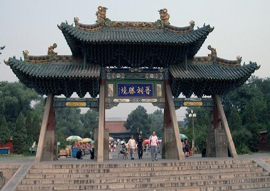Jinci Temple, located at the foot of the Xuanweng Mountain to the southwest of Taiyuan, is one of the most important historical relics under special protection of the government.
Jinci Temple was built in the Bei Wei Dynasty (386-534) in memory of Shuyu, the second son of Zhouwu Kingdom. The temple is a famous garden of ancient buildings, skirted by the mountain and the river, where ancient trees soar to unbelievable heights. It is in compound with hall, pavilions, and towers. The Saintly Mother's Hall, built from 1023 to 1032 during the Song Dynasty, is the most magnificent and oldest building remains of ancient in Jinci Temple. It is regarded as an important example to the study of the Song Dynasty architecture and to the history of architecture. The forty-three painted clay figures of maids were modeled vividly with natural miens and various expressions.
The long-life spring at south of the Saintly Mother's Hall is the source of Jin River. It runs without stopping and always ramains a constant temperature of 17 Celsius. Evergreen duckweed is shining in the stream and groups of fish always playing happily with each other. On the east of the Saintly Mother's Hall, the Flying Bridge across the Fish Ponds is the only and earliest 'cross' style bridge. On the right side of the Hall, there lies a slanted cypress of the Zhou Dynasty. The cypress, the long-life spring and the painted clay figures of maids in the Saintly Mother’s Hall are reputed as Jinci Temple's three wonders. |
